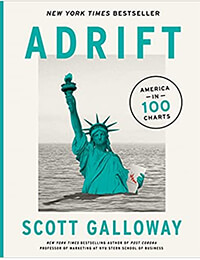 Book Review by Myra Salzer
Book Review by Myra Salzer
Adrift is my kind of book, and it will probably resonate with inheritors, wealth coaches, philanthropists, and family office personnel as well. Why? Because this book includes graphs that slice and dice American culture, politics, economics, healthcare, etc., etc. Each graph is a chapter in and of itself, clearly and concisely interpreted, accompanied by an explanation, and deftly summed up.
For example, one graph in the book reviews the revenue per trillion-dollar valuation of a corporation, showing how valuations are going up inversely to the degree of “bullsh*t” wording in a company’s mission statement. I enjoyed Galloway’s reference to “yogababble” when giving mission statement examples. At one end of the spectrum is Zoom’s mission statement: “To make video communications frictionless.” At the other end, Peloton’s is: “On the most basic level, Peloton sells happiness.” And Rivian’s: “If our planet is to continue to sustain life and enchant future generations, we must change. This is where Rivian’s potential lies.” Clarity and simplicity should trump ‘yogababble’ in all marketing forms, whether at the personal or philanthropic level.
Another graph from the book shows the CEO-to-Worker Compensation Ratio. In 1965, the CEOs of America’s largest 350 companies by revenue made 21 times the average compensation of their workers. By 2020, the CEO to worker compensation ratio shot to 351:1, a 1,670% increase. We all had a sense that CEO compensation was disproportionate to the contribution they made, but this graph brought this home!
Adrift doesn’t just review corporate data. For example, it highlights the U.S. incarceration rate, topping all other countries: 629 per 100,000 people are incarcerated in the U.S., compared to a mere 37 per 100,000 people in Japan!
There are a couple of graphs on higher education. (I think you can guess what the statistics might be for legacy acceptances at Ivy Leagues.) Galloway’s graphs also demonstrate how higher education doesn’t necessarily put young people on a pathway to prosperity. One graph includes information on how vocational training and apprenticeship programs vary by country. At the top, Denmark had 48 apprentices per one-thousand people in the labor force in 2019; in the U.S., that number was a mere 3 per 1,000 people.
I further appreciated how Galloway placed crime rates into perspective, revealing just how damaging the media is to our psyche. I would guess most surveyed people would think that crime rate has gone up in the U.S. in recent years, just because that’s much of what we hear on the news. That is not the case. Violent crimes have gone down precipitously between 1993 and 2015. The true magnitude of change is readily apparent in graph form.
Finally, Galloway examines the U.S. tax code, which in 1955 stood at 409,000 words. Today? Roughly 4 million words! Galloway estimates that completing tax returns took a total of 6.1 billion hours (yes that’s with a b) for all taxpayers.
This book is both interesting and useful. For TWC clients who feel overwhelmed with choosing causes for philanthropy, for example, it can serve as a good tool for homing in worthy causes, based on statistical review.
Adrift is easy to read, but a bit more challenging to digest.